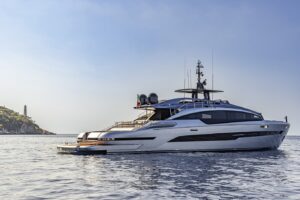Volvo Penta puts heart and soul into one-design boats
Together, the Volvo Ocean 65 Class racing boats formed the first fleet in the history of the Volvo Ocean Race to have the same design, the same engine and the same level of service through The Boatyard concept. World-class boats need world-class equipment, and Volvo Penta D2-75 Saildrive came as standard.
In June, Team Abu Dhabi Ocean Racing stormed to victory in Gothenburg, But even though the team excelled in training, and managed an almost perfect start during the first leg to Cape Town back in November, Abu Dhabi Ocean Racing quickly realized that the next nine months were going to be far from easy — the race’s revolutionary one-design concept standardized all boats, making the race a test of pure skill and endurance.
“The one-design element changed everything in this race. It made the fleet so much closer, and any risk you took, you weren’t just risking losing one or two places — you risked losing the whole fleet,” said the Abu Dhabi Ocean Racing navigator, Simon Fisher, in an earlier interview. “There were some opportunities where we’d look and think, ‘We could win the leg by miles, but if it doesn’t work out, we’ll be a long way behind.’”
“The one-design concept pushed sailors to their limits, making it a more rewarding journey for them and a more exciting spectator experience too,” says Knut Frostad, Volvo Ocean Race CEO and four-time race competitor. “But at the same time, having a standardized design across all seven boats made the race itself more cost efficient; the boats were stronger, more sustainable and had better overall performance.”
Volvo Penta as standard
At the heart of the common boat design is Volvo Penta; for the past nine months the D2-75 Saildrive has produced all onboard power via a 24-volt alternator system, which powered everything including position, route and weather forecast; contact with the outside world; power for the canting keel; clean water purification; and emergency propulsion.
“Volvo Penta supplies trustworthy, reliable engines that are renowned for their safety — and of course we are owned by the Volvo Group and Volvo Cars,” Knut explains. “But when we revealed the Volvo Ocean 65 Class, nobody questioned our choice of engine. We wanted an engine our sailors could trust because, ultimately, it’s responsible for their safety and wellbeing. The engine we chose had to ‘go the distance,’ literally and figuratively, and Volvo Penta delivered.”
In previous years each boat relied on two engines, one main engine and one backup, which were standard Volvo Penta engines customized to suit individual team specifications. But with standardization across all boats for the first time in the race’s history, each boat now relies on a single engine to power its around-the-world voyage. This update was due partly to cutting the size and the cost of powering each boat. But with an engine like Volvo Penta’s onboard, the team felt secure enough to eliminate the backup.
Indeed, putting complete faith in one engine was quite a risk, given the pressure it would be put under. The race alone is almost 40,000 nautical miles, and some teams clocked an additional 30,000 nautical miles in training — combined this is far more than the average engine covers in its lifetime. Together, the engines were able to produce enough energy to convert 94,500 liters of salt water into drinkable water and generate 51,030 kWh of power during the race itself.
“If the D2-75 is good enough for sailors competing in the world’s toughest offshore endurance race, it’s good enough for anyone,” says Knut, laughing. “The engine in each Volvo one-design boat is no different to a Volvo Penta engine found in an ordinary sailboat — that really does highlight the quality and superior performance of Volvo Penta’s products.”
A new era for ocean racing
Standardizing the fleet not only made for a closer race, but it transformed the way things operated behind the scenes too. In previous Volvo Ocean Races, each team would be accompanied by at least 15 to 25 service personnel, all dedicated to providing maintenance and support to one boat. Instead, a shared service was created known as The Boatyard concept — it carried spare parts and technology for all the yachts, not just one team.
Because The Boatyard concept made it far easier to diagnose any problems on the boat, the number of service personnel was cut by almost 70% — the teams’ shore crew numbers were reduced to as few as four. In this year’s edition, just 50 people in total traveled along with the Volvo Ocean Race to each stopover, providing service and maintenance to all seven teams.
Nick Bice, head of the Volvo Ocean Race Boatyard, says the centralized approach has had an impact on how things now operate behind the scenes:
“In previous Volvo Ocean Races we didn’t have this level of integration between the workshop and the teams, but the one-design boats and The Boatyard concept made all this possible,” he notes. “Magnus Gedda [Volvo Penta’s manager for technical service] has been instrumental. His knowledge and expertise helped troubleshoot problems when needed, but on the whole, the engines have exceeded all expectations — they’ve been very reliable, which is ideal in a race like this one.”
“Volvo Penta has proven itself to be an invaluable partner in this year’s Volvo Ocean Race — not only as a reliable supplier but also as a member of The Boatyard concept,” says Knut. “As a leading engine provider in the marine leisure industry, we look forward to working with Volvo Penta in years to come.”



